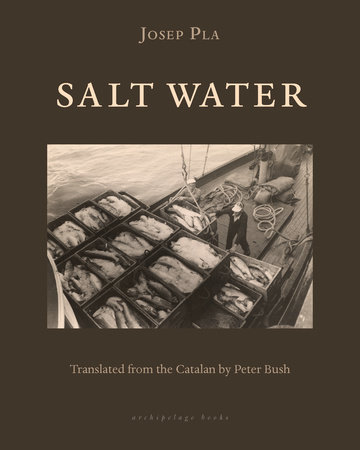Excerpt
Salt Water
STILL LIFE WITH FISH
Then, my dear friend, we lived in Fornells – not in the Fornells that is in Menorca, a shabby, squalid spot,
but Fornells in our country, a sheltered, delightful place. After wandering the world for so long, after so
much futile, wearisome activity, it was time for me to stop for a moment and rest a while. It was the right
decision: I went for a couple of weeks, and was still there a year later, far from hunger, work and stress.
At the time Fornells had no church, no public clock, no local government office, no embodiment of
legal authority. There wasn’t even a cemetery, which is surprising, given there are so many cemeteries in
this world. It meant those of us who lived there thought we would never die. If in the event anyone did, tears
prompted by the presence of death turned to icy anguish and the coffin was carried along the most unlikely
paths. There was an excellent source of water, under pine trees, with a large wash-place where young girls
with gleaming teeth and moist gums went to wash. In winter when the gods brought downpours, there was a
rush of water like a woman’s translucent thigh, green-blue veins under a pinkish body of water.
Small, nondescript houses were scattered around, connected to a distant hamlet by a series of tracks
and shortcuts. There wasn’t anything one could describe as an appreciable urban mass. Men and women, old
and young, all told we must have been some thirty-five individuals, and the houses we occupied were
detached, and separated by some distance. It would have been an exaggeration to call it a village: they were
simply fishermen’s houses set on a rocky landscape, in the most sheltered spots, surrounded by evergreen
mastic trees – small, whitewashed houses clinging to the ground, roofs touching the rock face, doors open to
the sea, pine branches giving a little shade to their façades. Rather than a strategy to communicate with
others, those houses represented a way of living extremely solitary lives.
Everything that goes with human life was there: no house was without a cat or two; three or four
dogs, of complex, mongrel stock, had settled in the area; a cockerel heralded our dawn; two old, shaggy,
good-natured asses seemed like remnants from a past long destroyed. Culture – what people generally call
culture – was little in evidence. There were no teachers and the laws related to state education were ignored.
If they wanted to study, children would have had to cover seven to ten or twelve miles there and back:
commonsense dictated that they went when they had nothing else to do, and even then it wasn’t a foregone
conclusion. We didn’t even have a single wretched volume of the Espasa Calpe dictionary to consult. We
received one or other of the daily newspapers, very late, in the form of wrapping around rice, noodles or
beans, which we rushed to read – or rather daydream over – if their dense pages didn’t first disappear into
the kitchen stove or the fire in the hearth. Women, in particular, had no respect for the printed page and were
always short of paper. It is undeniable: Fornells, in that era, was no hotbed of culture. Nevertheless, if you
wanted life with the taste of oblivion and remoteness that nervous exhaustion craves, it was a wonderfully
mellow place.
Sheltered from northerly winds by the Cape Begur cliffs, the land sits there like a earthenware dish
on its geological base – a sunny dish, open to the sun rising across the sea, and closed to the sunset by the
mountains. The land is poor but has been admirably cultivated with the noblest of crops: ancient silvery
olive groves, carob trees, cypresses, evergreen pines, almond trees and vines. Contemplated through their
majestic forms, sometimes bending under the richness of their sap, the sea was something bright and
beautiful, like an unexpected reassuring gift from nature. In early February, when almond trees blossomed
above the small ears and beady eyes of broad bean plants, the sea loomed across a pink haze. Bathed in the
wintry sun, the sweet yellow of the mimosas dazzled. Bronzed green oleanders had a reddish glow. Agave
plants on rocky ridges were streaked with an egg-yolk yellow. A scent of rosemary, gorse and lavender
floated in the air along paths melding with pine resin: it was a refreshing smell, a tangy, innocent delight
abroad.




